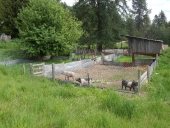
 2
2




Farmer at Cloud Nine Farm, located at 5300' elevation, on Sagebrush Steppe, northeast of Bridger Mountains in the Shields Valley of Montana. We do market gardens, four season growing, build earthworks, plant food forests, raise livestock and poultry, grow and sell plants and seeds, host WWOOFers, and more. Find our farm on facebook!








Farmer at Cloud Nine Farm, located at 5300' elevation, on Sagebrush Steppe, northeast of Bridger Mountains in the Shields Valley of Montana. We do market gardens, four season growing, build earthworks, plant food forests, raise livestock and poultry, grow and sell plants and seeds, host WWOOFers, and more. Find our farm on facebook!




 1
1









Farmer at Cloud Nine Farm, located at 5300' elevation, on Sagebrush Steppe, northeast of Bridger Mountains in the Shields Valley of Montana. We do market gardens, four season growing, build earthworks, plant food forests, raise livestock and poultry, grow and sell plants and seeds, host WWOOFers, and more. Find our farm on facebook!












Farmer at Cloud Nine Farm, located at 5300' elevation, on Sagebrush Steppe, northeast of Bridger Mountains in the Shields Valley of Montana. We do market gardens, four season growing, build earthworks, plant food forests, raise livestock and poultry, grow and sell plants and seeds, host WWOOFers, and more. Find our farm on facebook!




My Marxist Feminist Dialectic Brings All The Boys To The Yard!
 1
1




Farmer at Cloud Nine Farm, located at 5300' elevation, on Sagebrush Steppe, northeast of Bridger Mountains in the Shields Valley of Montana. We do market gardens, four season growing, build earthworks, plant food forests, raise livestock and poultry, grow and sell plants and seeds, host WWOOFers, and more. Find our farm on facebook!





My Marxist Feminist Dialectic Brings All The Boys To The Yard!








 !! And there is very little to no evidence of any undesirable weed presence. We did not mow this last summer at all.
!! And there is very little to no evidence of any undesirable weed presence. We did not mow this last summer at all.
Farmer at Cloud Nine Farm, located at 5300' elevation, on Sagebrush Steppe, northeast of Bridger Mountains in the Shields Valley of Montana. We do market gardens, four season growing, build earthworks, plant food forests, raise livestock and poultry, grow and sell plants and seeds, host WWOOFers, and more. Find our farm on facebook!
 1
1








Farmer at Cloud Nine Farm, located at 5300' elevation, on Sagebrush Steppe, northeast of Bridger Mountains in the Shields Valley of Montana. We do market gardens, four season growing, build earthworks, plant food forests, raise livestock and poultry, grow and sell plants and seeds, host WWOOFers, and more. Find our farm on facebook!








Aaron Potter wrote:Would this pasture mix do well in southwest Oklahoma?








Allison Said, ""Synergy West" contains a blend of: Orchardgrass, Perennial Ryegrass, Indian Ricegrass, Western and Snake River Wheatgrasses, Red and Ladino Clovers, Sainfoin, Small Burnett, Annual Sunflower, Birdsfoot Trefoil, Blue Flax, Chicory, Yellow Prairie Coneflower, Purple Prairie Clover, Purple Coneflower, Western Yarrow.
Invasive plants are Earth's way of insisting we notice her medicines. Stephen Herrod Buhner
Everyone learns what works by learning what doesn't work. Stephen Herrod Buhner




Brent Porter wrote:Do you have a list of the plants?
We have several locations on dry farms this sounds good to use. Our moisture comes mainly in snow with not very much summer rains.
JayGee

|
On my planet I'm considered quite beautiful. Thanks to the poetry in this tiny ad:
Learn Permaculture through a little hard work
https://wheaton-labs.com/bootcamp
|





